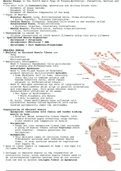Samenvatting
Summary Histology of Muscle Tissue
- Vak
- Instelling
- Boek
Summary of Junqueira: Histology of the Muscle with additional material from Netter's, DeFiore's and Weiss' Atlases. Includes abridged but detailed explanation of key point with Electron Microscopy, H&E, Immunohistochemistry and Diagrams.
[Meer zien]




